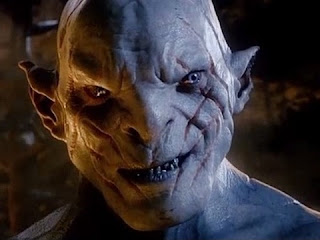"These were the Orcs, a multitude brought forth in shapes twisted by pain and hate. The only joy of these creatures was in the pain of others, for the blood that flowed within Orcs was both black and cold. Their stunted form was hideous: bent, bow-legged and squat. Their arms were long and strong as the apes of the South, and their skin was black as wood that has been charred by flame. The jagged fangs in their wide mouths were yellow, their tongues red and thick, and their nostrils and faces were broad and flat. Their eyes were crimson gashes, like narrow slits in black iron grates behind which hot coals burn."
"They were cannibals, ruthless and terrible, and often their rending claws and slavering fangs were gored with the bitter flesh and the foul black blood of their own kind. Orcs were spawned as thralls of the Master of Darkness; therefore they were fearful of light, for it weakened and burned them. Their eyes were night seeing, and they were dwellers of foul pits and tunnels."
Day then goes into the lengthy history of the repeated rise and fall of the race of Orcs through the ages until the period of time that is featured in Tolkein's books 'The Lord of the Rings', known as the Third Age of the Sun. Here they claim allegiance to the dark lord Sauron and were transformed into a new, stronger race using his powers of sorcery, a race that became termed 'Uruk-hai'.
"These Uruk-hai were Orcs grown to the height of Men, yet straight-limbed and strong. Though they were truly Orcs - black-skinned, black-blooded, lynx-eyed, fanged and claw-handed - Uruk-hai did not languish in sunlight and did not fear it at all."
Michael Stanton also comments on the origin of Orcs, including the different perspectives of characters within the story. He reiterates the fact that Tolkien explains the origin of the word Orc as being derived from Old English for 'demon'; the creatures themselves are ancient in Middle Earth.
Although Orcs are featured in 'The Hobbit' they are described as Goblins and described as such;
"...bow-legged, long-armed, fanged, squat but muscular, hairy and they smell bad."
Treebeard comments in The Two Towers that Orcs were made as a 'counterfeit' of Elves in the olden days, which has its merits but is not entirely true. Orcs do have a similar restorative drink to the Elves, however, it is apparently a much more foul-tasting draught.
Comparatives are often drawn between two different breeds of Orcs - those belonging to Saruman (stronger and bigger - Uruk-hai) and those belonging to Sauron (most sinister). It is thought that the evil within the Orcs makes them untrusting and untrustworthy, something which often works in the favour of the Hobbits and their tendency to turn on each other enables them to escape.















































